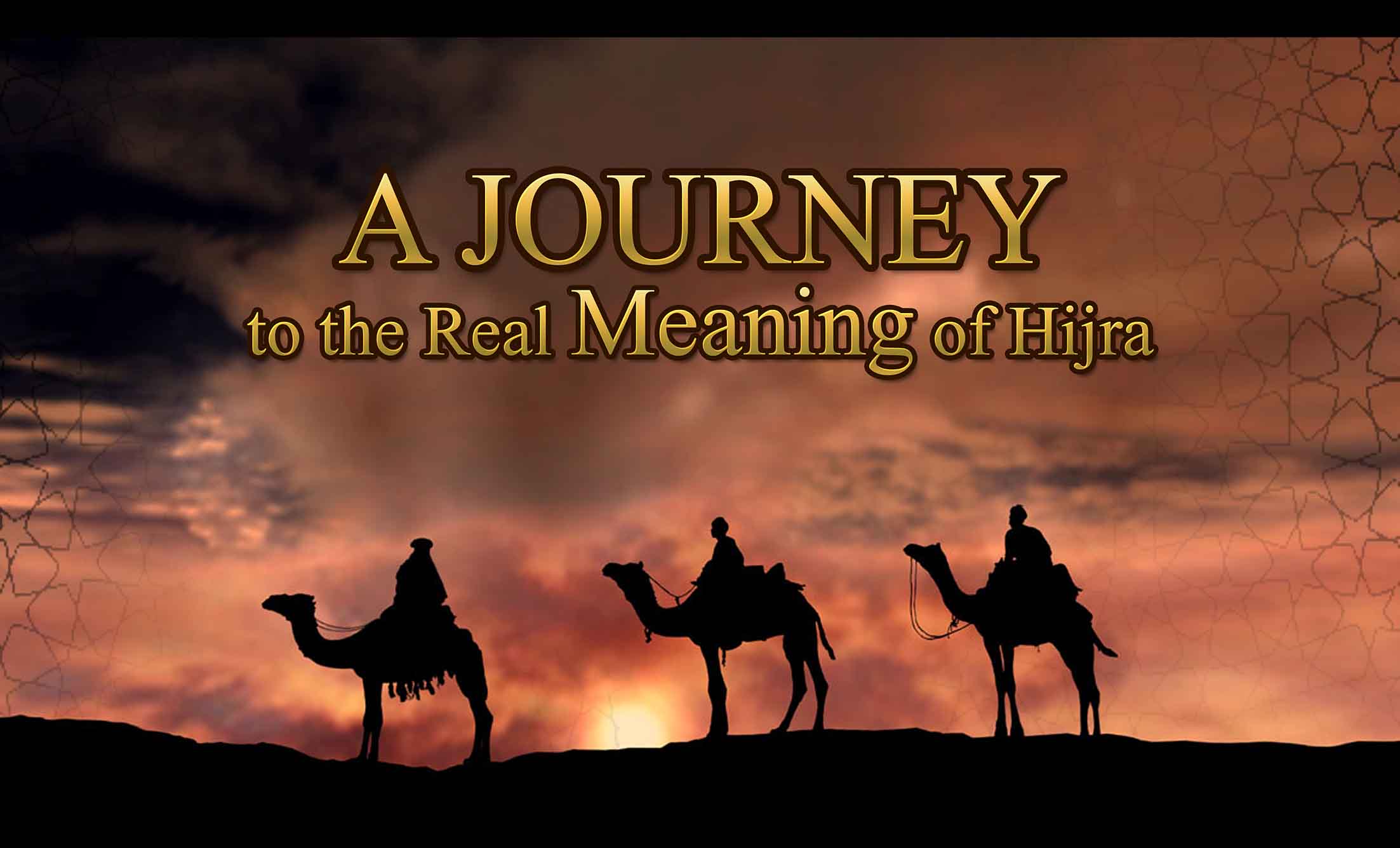Hijra | Hijri Islamic New Year
Table of Contents
ToggleThe Hijrah is an important event in Islamic history. In the year 622 CE, Prophet Muhammad and his followers made a journey. They left Mecca and went to Medina, which was then called Yathrib. This journey, known as the Hijrah, was key. It formed the Muslim community as we know it today.
This journey was more than just a move. The Arabic word “hijra” means breaking ties with what’s harmful. In Mecca, where they were from, they faced danger and threats. They moved to Medina for safety. This move was over 260 miles long, showing their strong faith.
Key Takeaways:
- The Hijrah was the migration of Prophet Muhammad and his followers from Mecca to Medina in 622 CE.
- The Hijrah marked the beginning of the Islamic calendar, which was introduced by Caliph Umar I in 639 CE.
- The Hijrah event established the first real Muslim community in Medina, enabling social, political, and economic independence.
- The Hijrah signified the transition from a small group of believers to an organized Islamic state with strong leadership and a growing number of followers.
- The Hijrah exemplifies the importance of Muslims bringing positive contributions to the lands they inhabit.
The Meaning of Hijrah
The Arabic word “hijra” translates to “a severing of ties of kinship or association.” It goes beyond just “flight.” This idea means cutting off friendly links or associations. It’s not just about moving away physically. It’s about leaving behind something that was once a part of you.
“Hijrah” has a rich history. Since 1753, it also means an exodus in English. In Islam, it refers to the emigration of the faithful to Abyssinia and of Muhammad’s followers to Medina. This was before the capture of Mecca in 630 CE. Those who migrated under Christian rule later were called “muhājirūn” or “emigrants.”
Background and Events Leading to the Hijrah
1- Situation in Medina
Medina sits over 260 miles north of Mecca. It was born as a lush haven by Jews who survived a Roman uprising. Along with small Jewish groups, the city housed three big Jewish tribes: Banu Qaynuqa, Banu Nadir, and Banu Qurayza. Southern Arabian tribes, Banu Aws and Banu Khazraj, also came. They lived with the Jews as Banu Qayla.
2- Muhammad’s Encounters with Aws and Khazraj Tribes
Before 620 CE, the Arab tribes of Aws and Khazraj fought for a century. They sought help from the Jewish tribes, leading to some strife. In 620 CE, Muhammad, unable to convert Mecca’s people, focused on others during fairs and pilgrimages. At this time, six Banu Khazraj members heard his message and converted. They hoped this might unite Khazraj and Aws, so they shared it in Medina.
| Statistic | Value |
|---|---|
| Distance of migration from Mecca to Medina | 320 kilometers (200 miles) |
| Year of the Hijrah | 622 CE |
| Number of early Muslim converts in Medina | Primarily from clans that had not produced great leaders and faced challenges from warlike leaders of other clans |
“The delegation from Medina, representing twelve important clans, invited Muhammad to serve as chief arbitrator for the community. They emphasized neutrality and leadership in this role.”
Hijra to Medina
In May 622 CE, Prophet Muhammad secretly left Mecca for Medina. He made this journey with Abu Bakr, his friend and father-in-law. This event, the Hijrah migration, was critical in Islamic history.
He could have reached Medina before his followers left Mecca. Yet, he stayed behind. This was to keep an eye on them and help those unsure. Eventually, all Muslims in Mecca joined him.
Forced to leave Mecca, Muhammad hid in a cave from Quraysh. They planned his assassination. To deceive them, Muhammad left his cousin Ali ibn Abi Talib in his place. He was protected by Muhammad
“The Hijrah route is described as mountainous and difficult terrain, requiring individuals to walk through meandering valleys that are rocky.”
The Hijrah migration was a testament to Muhammad‘s leadership. It was the start of the Islamic calendar. Muhammad laid the foundation for a strong Muslim community in Medina. This journey was key to the early Islamic empire’s growth.
Aftermath and Impact of the Hijrah
The Hijrah stands out as a key event in Islamic history. It’s the migration of Prophet Muhammad from Mecca to Medina in 622 CE. This journey changed the Muslim world’s course and started the use of the Islamic calendar, called the Hijri calendar.
Establishment of the Islamic Calendar
In 638 CE, Umar ibn Al-Khattab, the second Rashidun Caliph, set the year the Hijrah happened as the first year of the Islamic calendar. Known for short as AH, this Islamic calendar starts from the Hijrah. It’s still in use to list Hijri dates. About the exact date of the Hijrah, there’s a bit of debate. Some say it was on the first or second day of Rabi ‘u-l-awwal, the third month of the Arabian year.
The Islamic calendar works by the lunar method. It begins counting from the year of the Hijrah, around July 622 CE. This calendar is key to how Muslims all around the world celebrate important holidays and events.
“The Hijrah marks the starting point of the Muslim era and the establishment of the Islamic calendar, also known as the Hijri calendar.”
The Hijri calendar was officially taken up by the Ottoman government in 1677-78 (AH 1088). Today, it’s still widely used in many places with Muslim-majority populations. This shows how important the Hijrah was in shaping Islamic traditions.
The Hijrah not only started the Islamic calendar. It also changed Islam from an individual devotion to a complete way of life. It led to a community in Medina where religious, economic, and political life were united. This new phase in Islam’s history prepared the ground for its large-scale growth and the expansion of the Muslim empire.
The Ansar and Muhajiroon
Prophet Muhammad’s migration brought forth a unique group of Muslims, the “anṣār” or “helpers.” They were from Medina. These people warmly received and aided Muhammad and his followers from Mecca, the “muhājirūn.”
The “muhājirūn” were those who left Mecca for Medina with the prophet. They faced troubles and persecution in Mecca. The Quran hails their early faith and sacrifices. The “muhājirūn” were deeply respected in the growing Muslim community and later led after Muhammad died.
Then there were the “anṣār,” belonging to Medinese tribes that were rivals. These tribes, al-Khazraj and al-Aws, came together under Muhammad’s leadership. They then supported him, making up most of his forces at the crucial Battle of Badr in 624 CE.
The unbreakable bond between the “anṣār” and “muhājirūn” was created through a brotherhood pact. It linked individuals from each group like family. This boosted unity and friendship in the early Islamic community.
| Ansar | Muhajiroon |
|---|---|
|
|
The Ansar and Muhajiroon were key in Islam’s early days. They helped set up the first Muslim state in Medina. Their unity and bond, formed during the Hijrah, boosted Islam’s growth and reach.
Significance of the Hijra in Islamic History
The Hijrah refers to the migration of Prophet Muhammad and his followers from Makkah to Medina. This journey was very important in Islamic history. It marked the start of the first Muslim community and a new chapter for Islam. The significance of the Hijrah goes far beyond moving places. It set the stage for the growth and spread of Islam around the world.
The Hijri Calendar and Its Importance
One major result of the Hijrah was introducing the Islamic or Hijri calendar. This calendar is based on the moon and was set up in 639 CE by Umar I, the second caliph. It’s the main way Muslims keep track of time. The Hijri calendar is key for knowing the dates of important Islamic events like Ramadan and Eid.
Calculations of the Hijri Date
The Hijri calendar’s year starts on the first day of Muharram. This is the first month of the Islamic year. The Hijri year began on July 16, 622, in the Julian calendar. Back then, a new moon was likely spotted on the night of July 15, 622.
The Hijri calendar shows us the importance of the Hijrah in Islamic history. It’s not just a way to tell time for Muslims around the world. It also shows their strong connection to Islam’s teachings.
“The Hijrah represents a profound turning point in the history of Islam, as it marked the establishment of the first Muslim community and the beginning of a new era for the faith.”
Celebrations and Commemorations of the Hijrah
The Hijrah marks Prophet Muhammad’s move from Mecca to Medina. It is a key event in Islamic history. Muslims observe and celebrate this moment through Eid al-Adha and Eid al-Fitr.
Eid al-Adha is the “Festival of Sacrifice.” It honors Prophet Abraham’s readiness to sacrifice his son for Allah. This event reflects the sacrifices of early Muslims during the Hijrah.
Eid al-Fitr ends Ramadan, a time of fasting and reflection. This celebration marks a sacred journey’s completion. It shows a renewed dedication to Islamic values, thanks to the safe haven from the Hijrah.
Muslims also celebrate the Islamic New Year and Prophet Muhammad’s birthday. These events, based on the Hijri calendar, highlight the Hijrah’s historical and cultural contributions.
These traditions are global and unifying within the Muslim community. They are furthered through social media, exhibitions, and local events. These efforts help keep the Hijrah’s importance alive.
“The Hijrah marked the establishment of the first Islamic state and provided a safe environment for practicing Islam. It is a testament to the perseverance and sacrifice of the early Muslims, and a reminder of the enduring principles of faith, unity, and resilience that define the Islamic tradition.”
The Hijrah celebrations are more than symbolic. They connect Muslims with their historical roots. They inspire a future based on the early Islamic community’s principles.
The Constitution of Medina
When Prophet Muhammad reached Medina, he made a memorable agreement. It’s called the Constitution of Medina or the Medina Charter. This pact marked the start of the Muslim community as a social and political group. It detailed the rights and duties of the Muslim emigrants, local Muslim Helpers, and Jewish tribes in Medina.
Many experts, like Dr. Muhammad Hamidullah, see the Constitution of Medina as a groundbreaking text. They believe it’s the first written constitution ever. This document was key to building the Islamic state under Muhammad.
Some debate whether to call it a constitution, treaty, or charter. Questions around its exact form and authorship have come up. Despite this, versions provided by Abū ʿUbayd and Ibn Isḥāq are widely seen as accurate.
The Constitution covered a lot: dealing with prisoners, blood money, and debts relief. It also dealt with rebellion, protecting believers, and handling alliances. Moreover, it outlined rules for legal issues, like punishing murderers and sharing war costs between groups.
Medina was home to different groups, including local Arab tribes and Jewish tribes. The Constitution highlighted the rights and obligations of all citizens. It showed Muhammad as the political leader in this diverse state.
The Constitution of Medina was a crucial step in forming Islamic governance. It laid the foundation for the future Islamic empire. This document shows Muhammad’s skills in uniting different groups under his leadership.
| Key Aspects of the Constitution of Medina | Description |
|---|---|
| Authenticity and Composition | The authenticity of the document in its reported form has been questioned, with scholars reaching different conclusions on its exact composition and authorship. The versions provided by Abū ʿUbayd and Ibn Isḥāq are widely accepted as authentic. |
| Scope and Provisions | The Constitution addressed a wide range of issues, including the handling of prisoners, blood money, debts relief, rebellion, protection of believers, alliances, and inter-community relations. It also laid down rules for legal matters like retaliation for killing believers, protection of believers against non-believers, penalties for murderers, and the sharing of war expenses between Muslims and Jews in times of conflict. |
| Diverse Population of Medina | The population of Medina at the time included two supergroup local Arab tribes, the Aus and the Khazraj, with eight clans and 33 smaller groups under them, as well as around 20 Jewish tribes. The Constitution outlined the rights and duties of all citizens, establishing Muhammad’s political leadership over this multi-religious state. |
| Significance in Islamic History | The Constitution of Medina represented a landmark in the development of Islamic governance and laid the groundwork for the future growth of the Islamic empire. It stands as a testament to Muhammad’s political acumen and his ability to forge unity among diverse groups. |
The Constitution of Medina greatly influenced Islamic history. By defining roles in Medina, it set the stage for the Medina Charter and Muhammad’s political leadership. It helped the Islamic state to grow.
Hijrah in Modern Times
The concept of Hijrah remains important today. It started with the Prophet Muhammad moving from Mecca to Medina. Since then, Muslims have moved for many reasons, like leaving places under Christian rule.
Today, Hijrah means Muslim migrations around the world. People move looking for better lives or to avoid some problems. This movement has changed how Islam is spread and has affected cultures and politics.
Muslims have moved to the United States, Europe, and other Islamic states for many years. Notable migrations in history include going to Taif and Abyssinia, as well as Mecca to Medina. The journey of Prophet Muhammad and his followers from Mecca to Medina is very important. It even marks the start of the Islamic calendar. Today, the idea of Hijrah helps guide Muslims wanting a better life and the chance to freely practice their faith.
FAQ
What is the Hijrah?
The Hijrah marks the journey Muhammad and his supporters took from Mecca to Medina in 622 CE. This journey began the Islamic calendar, known as the Hijri calendar.
What is the meaning of the term “Hijrah”?
The term “Hijrah” means “a severing of ties of kinship or association” in Arabic. It talks about the move or migration of Muhammad and his followers from Mecca to Medina.
What was the situation in Medina before the Hijrah?
Medina was a fertile spot, home to Jewish tribes. The Banu Aws and Banu Khazraj, two Arab tribes, also lived there. They were in a long conflict, trying to win over the Jewish tribes.
How did the Hijrah take place?
In May 622 CE, Muhammad, along with his friend Abu Bakr, left Mecca for Medina. They found shelter in a cave at Mount Thawr to avoid their pursuers from Quraysh. These pursuers were trying to stop them from leaving.
What was the impact of the Hijrah?
The Hijrah was key in forming the Muslim community as a political body. It also began the use of the Islamic calendar, started by Umar I in 639 CE.
Who were the Ansar and Muhajiroon?
The Ansar were people of Medina who helped Muhammad and his followers, known as the Muhajiroon. These were the Meccans who migrated with Muhammad. The Muhajiroon were held in high regard among the early Muslim community.
How is the Hijrah celebrated and commemorated by Muslims?
Muslims honor and celebrate the Hijrah with special days, including Eid al-Adha, Eid al-Fitr, and the Islamic New Year. These key events are based on the Hijri calendar.
What was the significance of the Constitution of Medina?
When Muhammad arrived in Medina, he made a peace treaty with local clans known as the Constitution of Medina. This treaty set up the Muslim community as a unified political entity. It also outlined rights and duties of all living there.
How is the concept of Hijrah relevant in the modern era?
The idea of Hijrah is still important today. It stands for migration due to faith, a concept that has led Muslims to move throughout history. This includes leaving Christian lands to seek new opportunities.






